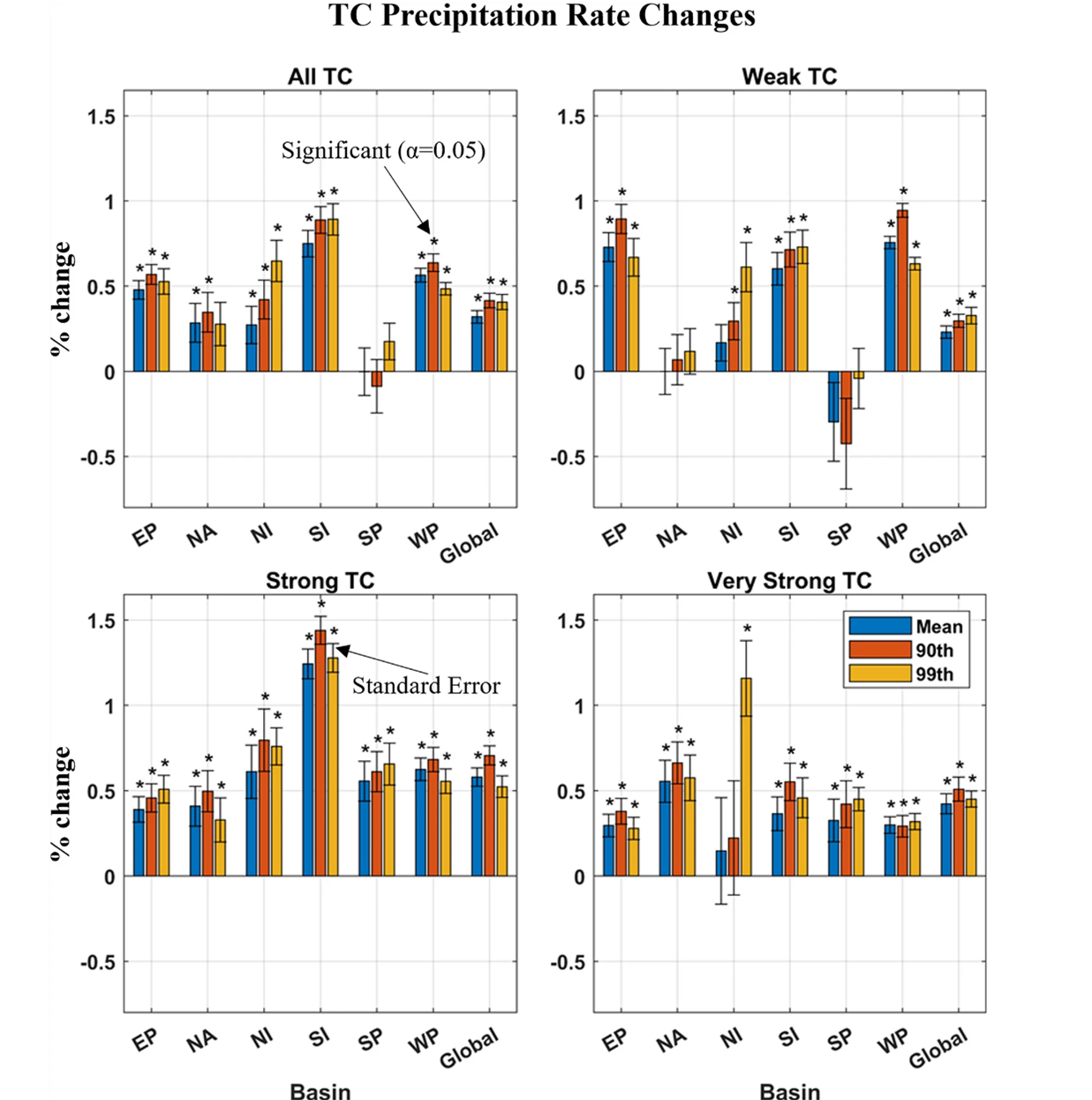CW3E Publication Notice
Unveiling Four Decades of Intensifying Precipitation from Tropical Cyclones Using Satellite Measurements
September 16, 2022
A new study entitled “Unveiling four decades of intensifying precipitation from tropical cyclones using satellite measurements” published in Scientific Reports and authored by Center for Hydrometeorology and Remote Sensing (CHRS) scientists Eric J. Shearer, Vesta Afzali Gorooh, Phu Dinh Nguyen, Kuo-lin Hsu, and Soroosh Sorooshian at UC Irvine shows that precipitation rates and volumes from tropical cyclones have intensified globally and in every basin over four decades from 1980 to 2019. The work contributes to the goals of CW3E’s 2019-2024 Strategic Plan of Monitoring and Projections of Climate Variability and Change.
This study examines rainfall rates from tropical cyclones during an extensive chunk of the satellite period using an experimental climate data record based on the PERSIANN-Dynamic Infrared Rain rate model (PDIR), with bias correction and homogenization by the gridded monthly gauge-derived Global Precipitation Climatology Project (GPCP) v2.3. This study was motivated by climate model predictions of increases in precipitation rates and volumes from tropical cyclones (TCs) caused by anthropogenic warming which have not yet been robustly detected in historical precipitation records at time scales long enough to overcome natural climate variability due to the relatively short temporal extent of existing precipitation observations. In the study, general increases in mean and extreme rainfall rates are detected. Overall, all basins have experienced intensification in precipitation rates with a 12–18%/40-year increase in global rainfall rates. Increases in rainfall rates have boosted the mean precipitation volume of global TCs by 7–15%/40 years, with basin-specific increases as great as 59–64% over 40 years. In terms of annual inland rainfall totals, year-by-year trends are generally positive due to increasing TC frequency, slower decay over land, and more intense rainfall, with an alarming increase of 81–85% over 40 years seen from the strongest global TCs. As the global trend in precipitation rates follows expectations from warming sea surface temperatures—11.1%/°C measured, 7-14% expected due to Clausius-Clapeyron to super Clausius-Clapeyron scaling)—it is hypothesized that the observed trends could be linked to anthropogenic warming creating greater concentrations of water vapor in the atmosphere, though thermodynamic evidence alone is insufficient to robustly make this claim.
This work was partially supported by the Ridge to Reef NSF Research Traineeship (#DGE-1735040), Future Investigators in NASA Earth and Space Science and Technology (#NNH19ZDA001N-FINESST), Department of Energy (#DE‐IA0000018), California Energy Commission (#300‐15‐005), Center for Western Weather and Water Extremes (CW3E) at the Scripps Institution of Oceanography via AR Program Phase II (#4600013361) sponsored by CA-DWR, and UK Research and Innovation Global Challenges Research Fund Living Deltas Hub Grant (#NES0089261).
Figure 1: Annual precipitation rate changes of mean and upper percentile precipitation rates by intensity classifications and basins— East Pacific (EP), North Atlantic (NA), North Indian (NI), South Indian (SI), South Pacific (SP), and West Pacific (WP). Rates are calculated from the average year-to-year increase of the fitted linear model. Asterisks represent statistical significance at α=0.05. During this period, global mean sea surface temperature increased at a rate of 0.13 °C/decade. Warming in the tropics occurs at ~75% the rate of global temperatures, translating into a ~0.10 °C/decade trend in the tropics.
Shearer, E.J., Afzali Gorooh, V., Nguyen, P. et al. Unveiling four decades of intensifying precipitation from tropical cyclones using satellite measurements. Sci Rep 12, 13569 (2022). https://doi.org/10.1038/s41598-022-17640-y.

